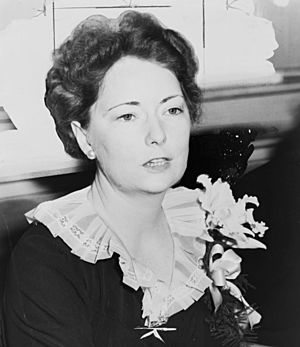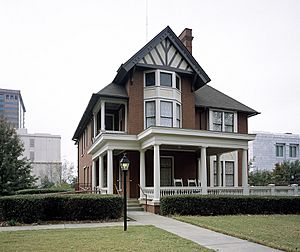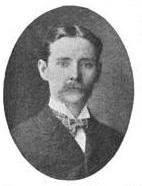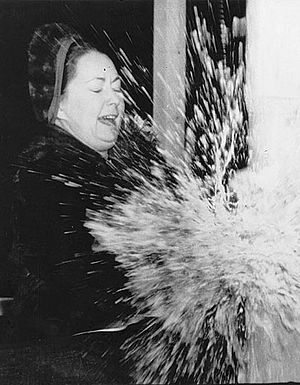Margaret Mitchell facts for kids
Quick facts for kids
Margaret Mitchell
|
|
|---|---|

Mitchell in 1941
|
|
| Born | Margaret Munnerlyn Mitchell November 8, 1900 Atlanta, Georgia, U.S. |
| Died | August 16, 1949 (aged 48) Atlanta, Georgia, U.S. |
| Resting place | Oakland Cemetery (Atlanta) |
| Pen name | Peggy Mitchell |
| Occupation | Journalist, novelist |
| Education | Smith College (MA) (honoris causa) |
| Genre | Romance novel, Historical fiction, epic novel |
| Notable works | Gone with the Wind Lost Laysen |
| Notable awards | Pulitzer Prize for Fiction (1937) National Book Award (1936) |
| Spouse |
Berrien Kinnard Upshaw
(m. 1922; div. 1924)John Robert Marsh
(m. 1925) |
| Parents | Eugene M. Mitchell Maybelle Stephens |
| Relatives | Annie Fitzgerald Stephens (grandmother) Joseph Mitchell (nephew) Mary Melanie Holliday (cousin) |
| Signature | |
Margaret Munnerlyn Mitchell (born November 8, 1900 – died August 16, 1949) was an American writer and newspaper reporter. She is famous for writing only one novel during her lifetime. This book was called Gone with the Wind. It was set during the American Civil War and the time after it. For this book, she won the National Book Award in 1936 and the Pulitzer Prize for Fiction in 1937. After she died, some of her early writings from when she was a girl were published. This included a short novel she wrote as a teenager called Lost Laysen. Also, a collection of her newspaper articles was later put into a book.
Contents
Margaret Mitchell's Family History
Margaret Mitchell was born in 1900 in Atlanta, Georgia. She lived there her whole life. Her family was wealthy and well-known in politics. Her father, Eugene Muse Mitchell, was a lawyer. Her mother, Maybelle Stephens, worked for women's right to vote. She also helped the Catholic community. Margaret had two brothers. One died as a baby, and the other was Alexander Stephens Mitchell.
Margaret's family on her father's side came from Scotland. They settled in Georgia in 1777. Her great-grandfather, Issac Green Mitchell, moved to a farm in the Flat Rock community in 1839.
Her grandfather, Russell Crawford Mitchell, joined the Confederate States Army in 1861. He was hurt in a big battle called the Battle of Sharpsburg. After the Civil War, he became rich by supplying wood to rebuild Atlanta.
Margaret's mother's family came from Ireland. Her great-grandfather, Philip Fitzgerald, settled on a large farm near Jonesboro, Georgia. Her grandparents, Annie Fitzgerald and John Stephens, married in 1863. John Stephens was also from Ireland and fought in the Confederate Army. After the war, he became a successful real estate developer. He also helped start Atlanta's first trolley system. John and Annie had twelve children, and May Belle was one of them. May Belle studied at a convent school and finished her education in Atlanta.
Margaret's Early Life and Influences
Margaret Mitchell grew up on Jackson Hill in Atlanta. Her family lived near her grandmother, Annie Stephens. Her grandmother was a strong character and told Margaret many stories. These stories were about the Civil War and the time after it, called Reconstruction.
Growing Up on Jackson Hill
When Margaret was about three, her dress caught fire. To keep her safe, her mother started dressing her in boys' pants. She was nicknamed "Jimmy" after a comic strip character. Her brother said she had to be a boy named Jimmy to play with him. Margaret said she was a boy until she was fourteen.
Her brother said Margaret was a tomboy. She liked to ride her pony. As a child, Margaret often rode with an old Confederate soldier and a young lady. She learned many details about battles from these visits. But she did not know the South had lost the war until she was ten years old. She said it was a "violent shock" to learn that General Lee had been defeated.
Margaret's mother, May Belle, wanted her to behave. She took Margaret to a women's suffrage rally. This was a meeting where women spoke about getting the right to vote. Margaret sat on the stage wearing a "Votes-for-Women" banner. When Margaret was nineteen, the Nineteenth Amendment was passed. This law gave women the right to vote.
May Belle Mitchell was very active in her community. She was president of the Atlanta Woman's Suffrage League. She also helped start Georgia's League of Women Voters.
Margaret's father, Eugene Mitchell, did not like physical punishment in schools. When he was president of the school board, hitting students in public schools was stopped.
Jackson Hill was a wealthy part of Atlanta. Below it was an area of African-American homes. In September 1906, when Margaret was five, there was a riot in Atlanta. White newspapers printed false stories about black men. This caused a large angry crowd to gather. People were pulled from streetcars and attacked. As the riot continued, there were rumors that Jackson Hill would be burned. Eugene Mitchell, who did not own a gun, stood guard with a sword. Margaret remembered feeling terror during this time.
A few years later, in 1912, the Mitchell family moved to a new home on Peachtree Street. Their old home on Jackson Hill was destroyed in the Great Atlanta Fire of 1917.
Margaret's father was Protestant, but her mother was Catholic. Margaret was raised Catholic. Her religious background influenced her book. She made the O'Hara family in her novel Catholic in a state that was mostly Protestant.
The South of Gone with the Wind
When Margaret was six, her mother took her on a tour of ruined farms. They saw chimneys that were left standing after William Tecumseh Sherman's army marched through Georgia. These ruins helped Margaret imagine "the South" that she would later write about.
An Avid Reader
Margaret loved to read. She read adventure stories for boys. Her mother read novels to her before she could read herself. They both cried while reading books about the Civil War. She also read plays by William Shakespeare and novels by Charles Dickens and Sir Walter Scott. Two of her favorite children's books were Five Children and It and The Phoenix and the Carpet by Edith Nesbit.
As a teenager, Margaret read books by Thomas Dixon. These books were about the Civil War and Reconstruction. She liked them so much that she put on plays based on them with other children.
Young Storyteller
Margaret Mitchell was a very imaginative writer from a young age. She started by writing stories about animals. Then she wrote fairy tales and adventure stories. She made her own book covers and bound the pages together. At age eleven, she called her publishing company "Urchin Publishing Co." Her mother kept many boxes of her stories.
Margaret often put herself in her stories. She was a character riding a pony in The Little Pioneers. She also played "Cowboys and Indians" in When We Were Shipwrecked.
Themes of love and honor appeared in her early stories. In The Knight and the Lady, two knights fight for a lady. In The Arrow Brave and the Deer Maiden, a brave must show honor to win the girl. These themes became very important in Lost Laysen, which she wrote as a teenager. They were also key in her famous novel, Gone with the Wind.
She also wrote stories set in other places, like a cowboy story in Mexico. In 1913, she wrote two stories about the Civil War. One of them was 237 pages long.
School Life
During World War I (1914–1918), Margaret Mitchell went to Washington Seminary in Atlanta. This was a private school for girls. She was very active in the Drama Club. She often played male characters in Shakespeare's plays. She also wrote a play about snobby college girls and acted in it. Two of her stories were published in the school yearbook.
Her English teacher, Mrs. Paisley, saw Margaret's writing talent. She told Margaret that she had ability if she worked hard. She taught Margaret to write "complete, concise and coherent" sentences.
In 1916, Margaret dramatized a book by Thomas Dixon called The Traitor. She was both the writer and an actress in the play. She played the role of Steve Hoyle and even made a Ku Klux Klan costume for it.
During her school years, Margaret's brother, Stephens, was at Harvard College. In 1917, he joined the army and went to France. He returned to Georgia in 1918.
Stephens Mitchell thought college was bad for girls. But Margaret's mother believed education was very important for women. She wanted Margaret to use her mind and saw education as a "key to survival." Her mother chose Smith College in Massachusetts for Margaret. She thought it was the best women's college in the United States.
After finishing Washington Seminary in 1918, Margaret fell in love with Clifford West Henry. He was a young army lieutenant. Before he left for France, he gave Margaret an engagement ring.
While Margaret was at Smith College, Henry was badly wounded in France. He died on October 17, 1918. He was awarded medals for his bravery. Margaret's brother said Clifford Henry was the great love of her life.
Margaret had thought about a career in psychiatry. But her plans changed because of the 1918 flu pandemic. On January 25, 1919, her mother, May Belle Mitchell, died from the "Spanish flu." Margaret came home from college the day after her mother died.
Margaret was an average student at Smith College. She did not think her writing was very good, even though her professor praised it. After her first year, Margaret returned to Atlanta to take care of her father and the household. She never went back to college. She felt sad about giving up her dreams of a "journalistic career."
Marriage and Life in Atlanta
Margaret started using the nickname "Peggy" in high school. Later, at Smith College, she used "Peg." She made her debut in Atlanta society in 1920. She was known for her lively style. At a charity ball in 1921, she performed a dance that shocked Atlanta society. This led to her being blacklisted from the Junior League.
In 1922, Margaret was seeing two men: Berrien ("Red") Kinnard Upshaw and John Robert Marsh. John Marsh was Red's roommate and a newspaper editor.
Margaret and Red married on September 2, 1922. John Marsh was the best man. But their marriage did not last long. Red left by December, and they divorced in October 1924.
During this time, Margaret left the Catholic Church and became an Episcopalian.
On July 4, 1925, Margaret Mitchell and John Marsh married. They made their home in an apartment in Atlanta. They called it "The Dump." Today, this apartment is the Margaret Mitchell House and Museum.

Reporter for The Atlanta Journal
While still married to Red Upshaw, Margaret needed money. She got a job writing articles for The Atlanta Journal Sunday Magazine. Her family and friends did not encourage her to be a journalist. She had no newspaper experience before this.
Her first story appeared on December 31, 1922. She wrote about many topics, from fashion to Civil War generals. She even interviewed the famous actor Rudolph Valentino. She was excited when Valentino carried her inside from a hotel rooftop.
Many of her stories were very descriptive. In one article, she wrote about four notable Georgia women. One was Rebecca Latimer Felton, the first woman to serve in the United States Senate. This article caused some debate among her readers. Margaret received criticism for showing "strong women who did not fit the accepted standards of femininity."
Margaret's journalism career lasted less than four years. Her last article was in May 1926. After marrying John Marsh, she quit because of an ankle injury that would not heal. She chose to be a full-time wife. During her time at the Atlanta Journal, she wrote 129 feature articles and many news stories.
Novelist
Early Works
Lost Laysen
When Margaret was fifteen (1916), she wrote a short romance novel called Lost Laysen. She gave it to a boyfriend, Henry Love Angel. He died in 1945, and the book was found among his letters in 1994. It was published in 1996, eighty years after she wrote it. It became a New York Times Best Seller.
Ropa Carmagin
In the 1920s, Mitchell wrote another short novel, Ropa Carmagin. It was about a Southern white girl who loved a biracial man. She sent it to a publisher with Gone with the Wind. But it was rejected because it was too short.
Writing Gone with the Wind
In May 1926, Margaret was recovering from her ankle injury. She started writing a society column for a magazine. John Marsh brought home a typewriter for her. For the next three years, Margaret worked on her Civil War novel. The main character was first named Pansy O'Hara, but it was changed to Scarlett before the book was published. She even used parts of her manuscript to prop up a wobbly couch!
World War II Efforts
During World War II, Margaret Mitchell volunteered for the American Red Cross. She helped raise money for the war by selling war bonds. She also sewed hospital gowns. She spent a lot of time writing letters to soldiers, sailors, and marines. She sent them humor, encouragement, and sympathy.
Margaret Mitchell sponsored a ship named the USS Atlanta (CL-51). This was a light cruiser used to fight airplanes. It was used in important naval battles. The ship was badly damaged in 1942 and later sunk. It earned five battle stars for its brave fighting.
Mitchell also sponsored a second ship named after Atlanta, the USS Atlanta (CL-104). She christened the ship in 1944. This ship also fought in the war and earned two battle stars.
Death and Legacy
On August 11, 1949, Margaret Mitchell was hit by a speeding car. She was crossing Peachtree Street in Atlanta with her husband, John Marsh. They were on their way to see a movie. She died five days later, on August 16, at age 48. She never fully woke up.
The driver was an off-duty taxi driver. He was later found guilty of involuntary manslaughter and served almost 11 months in jail.
Margaret Mitchell was buried at Oakland Cemetery in Georgia. When her husband John died in 1952, he was buried next to her.
Margaret Mitchell has been honored many times. She was inducted into the Georgia Newspaper Hall of Fame in 1978. She was also recognized by the Georgia Women of Achievement in 1994 and the Georgia Writers Hall of Fame in 2000.
In 1994, a TV movie called A Burning Passion: The Margaret Mitchell Story was made about her life.
When Mitchell's nephew, Joseph Mitchell, died in 2011, he left half of the rights to Margaret Mitchell's books and trademarks to the Archdiocese of Atlanta.
Images for kids
-
Stereoscope card showing the business district on Peachtree Street around 1907. The Mitchells' new home was about 3 miles from here.
See also
 In Spanish: Margaret Mitchell para niños
In Spanish: Margaret Mitchell para niños








